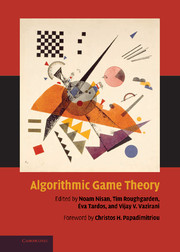Book contents
- Frontmatter
- Contents
- Foreword
- Preface
- Contributors
- I Computing in Games
- II Algorithmic Mechanism Design
- III Quantifying the Inefficiency of Equilibria
- 17 Introduction to the Inefficiency of Equilibria
- 18 Routing Games
- 19 Network Formation Games and the Potential Function Method
- 20 Selfish Load Balancing
- 21 The Price of Anarchy and the Design of Scalable Resource Allocation Mechanisms
- IV Additional Topics
- Index
21 - The Price of Anarchy and the Design of Scalable Resource Allocation Mechanisms
from III - Quantifying the Inefficiency of Equilibria
Published online by Cambridge University Press: 31 January 2011
- Frontmatter
- Contents
- Foreword
- Preface
- Contributors
- I Computing in Games
- II Algorithmic Mechanism Design
- III Quantifying the Inefficiency of Equilibria
- 17 Introduction to the Inefficiency of Equilibria
- 18 Routing Games
- 19 Network Formation Games and the Potential Function Method
- 20 Selfish Load Balancing
- 21 The Price of Anarchy and the Design of Scalable Resource Allocation Mechanisms
- IV Additional Topics
- Index
Summary
Abstract
In this chapter, we study the allocation of a single infinitely divisible resource among multiple competing users. While we aim for efficient allocation of the resource, the task is complicated by the fact that users' utility functions are typically unknown to the resource manager. We study the design of resource allocation mechanisms that are approximately efficient (i.e., have a low price of anarchy), with low communication requirements (i.e., the strategy spaces of users are low dimensional).
Our main results concern the proportional allocation mechanism, for which a tight bound on the price of anarchy can be provided. We also show that in a wide range of market mechanisms that use a single market-clearing price, the proportional allocation mechanism minimizes the price of anarchy. Finally, we relax the assumption of a single market-clearing price, and show that by extending the class of Vickrey–Clarke–Groves mechanisms all Nash equilibria can be guaranteed to be fully efficient.
Introduction
This chapter deals with a canonical resource allocation problem. Suppose that a finite number of users compete to acquire a share of an infinitely divisible resource of fixed capacity. How should the resource be shared among the users? We will frame this problem as an economic problem: we assume that each user has a utility function that is increasing in the amount of the resource received, and then design a mechanism to maximize aggregate utility.
- Type
- Chapter
- Information
- Algorithmic Game Theory , pp. 543 - 568Publisher: Cambridge University PressPrint publication year: 2007
- 16
- Cited by



